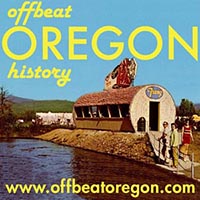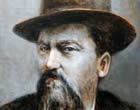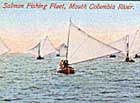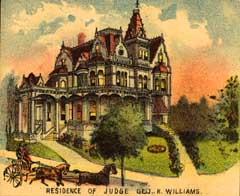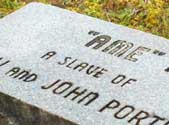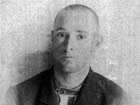The ghost town of Ellendale,
in Polk County
An interview with the elderly Newton McDaniel about life in western Polk County during the Gold Rush era, long before statehood, conducted by Ardyth Gibbs of the WPA Writers Project.
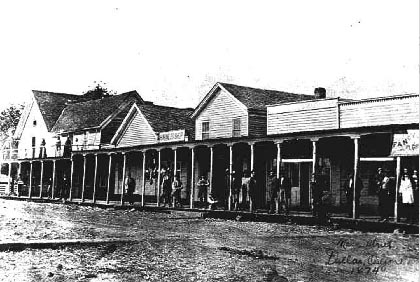
The main street in Dallas, a few miles away from Ellendale, as it looked
in 1874. (Image: Salem Public Library)
By Ardyth Gibbs — Date unknown, 1937
Edited by Finn J.D. John — April 17, 2013
Editor's Note: This is one of the very earliest of the Oregon stories from the Works Progress Administration’s Writers’ Project. It was conducted by Ardyth Gibbs sometime in the winter of 1937-1938, when she spoke to Mr. Newton McDaniel at his home in Portland, 1413 S.W. 14th Ave.; the paperwork was partially filled out, and it languished in some government vault until Oct. 10, 1940. By that time, Ms. Gibbs was no longer working with the project, and Mr. McDaniel had died. So a lot of follow-up questions that we would have loved to have the answers to — how old Mr. McDaniel was, how he fit into the story, how he came to be in the Willamette Valley — can only be speculated about.
It’s anyone’s guess whether McDaniel lived through the times he was talking about, but he would have had to be incredibly old to have done so. If he’d been 10 years old in 1848, that would put him right at age 100 when the interview was done. Some of the stories he tells also have that too-perfect feel that often means they’ve been augmented over the years; for instance, when he says the newspaper editorialized against a lynching and every single subscriber canceled. That’s not the kind of thing that happens in real life, especially not in a frontier town where the editor of the local newspaper is part of the community and knows lots of people.
Nonetheless, it’s a valuable if fleeting glimpse into an era in Oregon that was rough, sketchy and profoundly lawless, when the beautiful pastoral Willamette Valley was part of an edgy, dangerous wildland at the far corner of the world. For that reason, if for no other, it’s worth preserving.
With that, here is the statement Newton McDaniel gave to Ardyth Gibbs that winter day:
Ellendale was founded in 1845 by James O'Neal, in Polk County, four miles west, above Dallas. He went into the flour mill business and chose, because of the water, the spot on which a little town flourished for a few years and then died, and now is as if it had never been.
He ran the mill about four years and then sold it to Colonel Nesmith and Harry Owens. They in turn sold it to the Hudson's Bay Company, in 1854. A post office had been established there in 1850, and was named O'Neal's Mills. There never at any time was more than a handful of residents but that handful accommodated a great many travelers with meals and lodgings for the night.
Parties of miners in '48 and '49 used to came there to buy flour for their pack trains.
Ellendale was named for Ellen Lyon. She married Judge R. P. Boise, Circuit Judge in Polk County, and two of their sons are Whitney and Reuben Boise.
Most of the people thereabouts, the Hallocks, Lyles and Lyons, were farmers. Ellendale probably perished because it was destined to perish, and because folks started to take another road, and because the water failed.
They had some colorful murders, though — if not right in Ellendale, at least in Polk County. A bartender killed a hot-headed fool of a man in a fair fight, and later, also in a fair fight, he killed the man's son, who had burst in, guns popping, to get revenge.
When the citizens, avid at the sight of all the spilled blood, and hoping against hope for the ineffable thrill of another such sensation, went to the only son left, a younger brother of the dead lad, and asked him if he was going to kill the bartender and "get even," he said, "Hell, no. I'm not a very good shot anyway, and I'd be killed as sure as blazes, and besides I don't want to get even, and Bub hadn't ought to have butted in to other people's business. Pop had what was comin' to him." (Which indeed he had had, being one of the most disagreeable men in the country).
He grew to be an honored and respected citizen, and was lauded as a level-headed gentleman to the end of his long life. The bartender was killed ten months after in a brawl over cards in Prineville.
Once an infuriated mob hanged a part-Indian because, in a drunken frenzy, he had hacked his meek blonde wife and her unborn child to pieces. His father, J. P. Kelty, a rich man, would not put up a cent for his defense, which made little difference as an angry group took justice into their own hands and the second day of the trial strung him up "higher than a kite," before nightfall.
When the Editors of a Polk County paper protested against such an action, every single subscriber stopped taking the paper and they had to sell out.
Two items of no particular importance:
"Lid" was the name given to a man's hat by the Indians and not by the buckaroos, as some suppose.
And do you know where the names Big Nestucca and Little Nestucca came from?
This is the story that was told in Portland:
General Grant, Sherman, and Colonel Nesmith went over into that country. They thought some of taking Indian wives — temporarily, of course — and would have, only there was just one Indian woman available. The rest were gone into the mountains, for herbs, or had passionately jealous husbands.
They all tried to win her but the successful one was Colonel Nesmith. Nes' tuck 'er. (Nestucca).
At any rate, that's the story that went the rounds in Oregon, much to the merriment of the pioneers.

